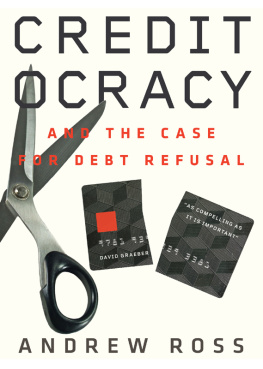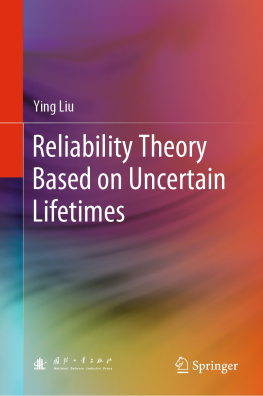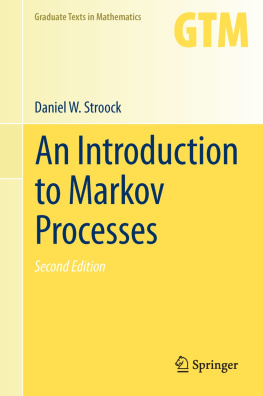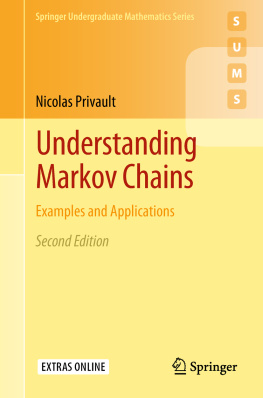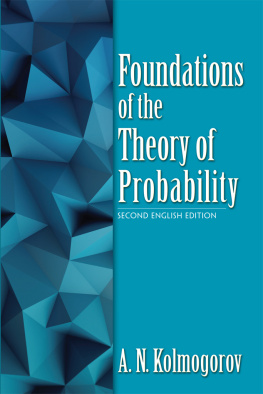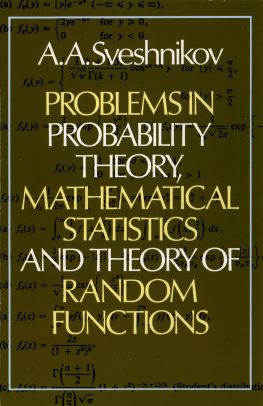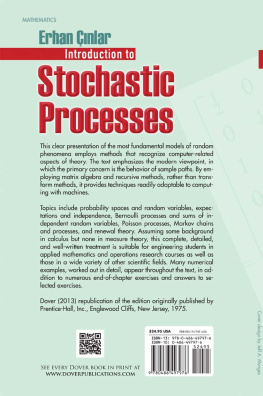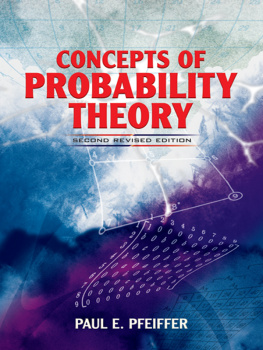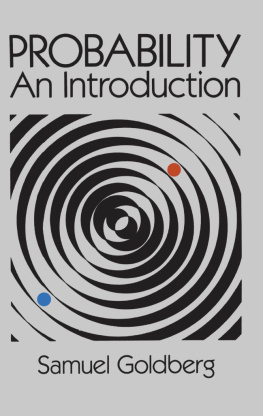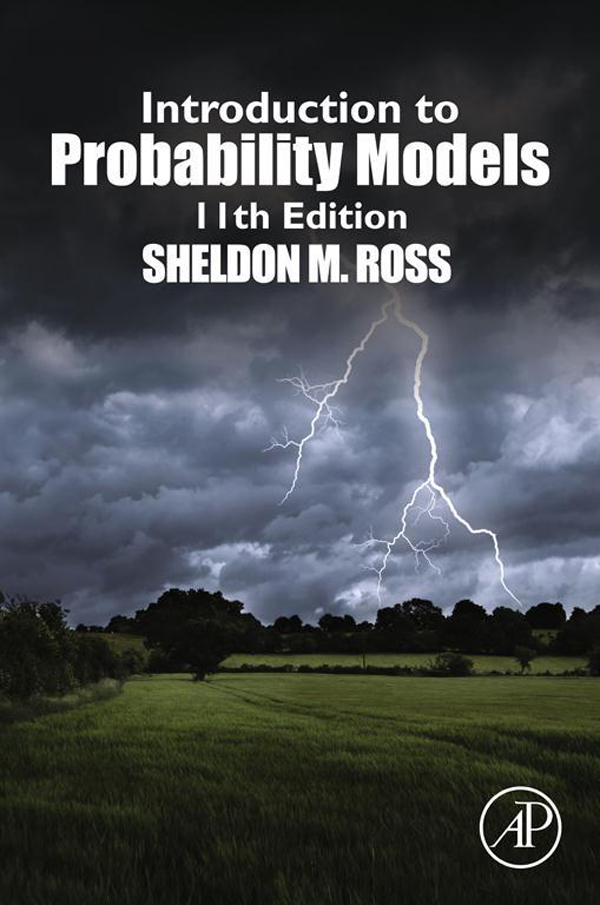Table of Contents
List of tables
- Tables in Random Variables
- Tables in Renewal Theory and Its Applications
- Tables in Simulation
List of illustrations
- Figures in Random Variables
- Figures in Conditional Probability and Conditional Expectation
- Figures in Markov Chains
- Figures in The Exponential Distribution and the Poisson Process
- Figures in Continuous-Time Markov Chains
- Figures in Renewal Theory and Its Applications
- Figures in Queueing Theory
- Figures in Reliability Theory
- Figures in Brownian Motion and Stationary Processes
- Figures in Simulation
Landmarks
Table of Contents
Introduction to Probability Models
Eleventh Edition
Sheldon M. Ross

Copyright
Academic Press is an imprint of Elsevier
The Boulevard, Langford Lane, Kidlington, Oxford OX5 1GB, UK
Radarweg 29, PO Box 211, 1000 AE Amsterdam, The Netherlands
225 Wyman Street, Waltham, MA 02451, USA
525 B Street, Suite 1800, San Diego, CA 92101-4495, USA
Eleventh edition 2014
Tenth Edition: 2010
Ninth Edition: 2007
Eighth Edition: 2003, 2000, 1997, 1993, 1989, 1985, 1980, 1972
Copyright 2014 Elsevier Inc. All rights reserved.
No part of this publication may be reproduced, stored in a retrieval system or transmitted in any form or by any means electronic, mechanical, photocopying, recording or otherwise without the prior written permission of the publisher Permissions may be sought directly from Elseviers Science & Technology Rights Department in Oxford, UK: phone (+44) (0) 1865 843830; fax (+44) (0) 1865 853333; email: , and selecting Obtaining permission to use Elsevier material.
Notice
No responsibility is assumed by the publisher for any injury and/or damage to persons or property as a matter of products liability, negligence or otherwise, or from any use or operation of any methods, products, instructions or ideas contained in the material herein. Because of rapid advances in the medical sciences, in particular, independent verification of diagnoses and drug dosages should be made.
Library of Congress Cataloging-in-Publication Data
Ross, Sheldon M., author.
Introduction to probability models / by Sheldon Ross. Eleventh edition.
pages cm
Includes bibliographical references and index.
ISBN 978-0-12-407948-9
1. Probabilities. I. Title.
QA273.R84 2014
519.2dc23
2013035819
British Library Cataloguing in Publication Data
A catalogue record for this book is available from the British Library
ISBN: 978-0-12-407948-9
For information on all Academic Press publications visit our web site at store.elsevier.com
Printed and bound in USA
Transfer to Digital in 2014

Preface
This text is intended as an introduction to elementary probability theory and stochastic processes. It is particularly well suited for those wanting to see how probability theory can be applied to the study of phenomena in fields such as engineering, computer science, management science, the physical and social sciences, and operations research.
It is generally felt that there are two approaches to the study of probability theory. One approach is heuristic and nonrigorous and attempts to develop in the student an intuitive feel for the subject that enables him or her to think probabilistically. The other approach attempts a rigorous development of probability by using the tools of measure theory. It is the first approach that is employed in this text. However, because it is extremely important in both understanding and applying probability theory to be able to think probabilistically, this text should also be useful to students interested primarily in the second approach.
New to This Edition
The eleventh edition includes new text material, examples, and exercises. Some of the key new examples are the following.
, which derives the density function of the t-random variable.
, which analyzes a serve and rally competition where the winner of a rally is the server for the next point.
, which considers a one lane road with no overtaking.
, which uses the reverse chain to analyze a sequential queuing system.
, which analyzes a system where both people and buses randomly arrive at a bus stop.
New sections include
, on the long-run proportions and limiting probabilities of a Markov chain.
, on random intensity functions and Hawkes processes.
, on the reverse chain of continuous-time Markov chains.
, which analyzes the maximum variable of a Brownian motion with drift process.
We have also tried to simplify and clarify existing material wherever possible. Examples include a new proof of the result that the number of events of a nonhomogeneousPoisson process that occur in an interval is Poisson distributed, as well as the introduction of Walds Equation () and its subsequent use in provingthe elementary renewal theorem.
Course
Ideally, this text would be used in a one-year course in probability models. Other possible courses would be a one-semester course in introductory probability theory (involving , as the basis of an introductory course in queueing theory.
Examples and Exercises
Many examples are worked out throughout the text, and there are also a large number of exercises to be solved by students. More than 100 of these exercises have been starred and their solutions provided at the end of the text. These starred problems can be used for independent study and test preparation. An Instructors Manual, containing solutions to all exercises, is available free to instructors who adopt the book for class.
Organization
gives a simple derivation of the joint distribution of the sample mean and sample variance of a normal data sample.
presents k -record values and the surprising Ignatovs theorem.
In introduces Markov chain Monte Carlo methods. In the final section we consider a model for optimally making decisions known as a Markovian decision process.
In gives a simple derivation of the convolution of exponential random variables.
presents the computationally important technique of uniformization.
, we suppose the random variables are continuous and derive an expression for the mean time until a run of m consecutive increasing values occurs.
, concerned with a single server, general service time queue in which the arrival source is a finite number of potential users.
analyzes a series structure reliability model in which components enter a state of suspended animation when one of their cohorts fails.
is concerned with Brownian motion and its applications. The theory of options pricing is discussed. Also, the arbitrage theorem is presented and its relationship to the duality theorem of linear programming is indicated. We show how the arbitrage theorem leads to the BlackScholes option pricing formula.
introduces the valuable simulation technique of importance sampling, and indicates the usefulness of tilted distributions when applying this method.






